University Strategic Management Analysis: Woolworths Group Report
VerifiedAdded on 2021/09/12
|12
|2770
|56
Report
AI Summary
This report provides a comprehensive strategic management analysis of the Woolworths Group, an Australian retail company. It begins with an executive summary and introduction, then delves into external environmental analysis using Porter's Five Forces and PESTEL frameworks, examining political, legal, and socio-cultural factors. The internal environment is assessed through resources, capabilities, core competencies, and a value chain analysis covering inbound logistics, operations, outbound logistics, marketing, and customer service. The report then evaluates Woolworths' competitive advantages, strategy formulation, including goals, vision, and initiatives, and offers recommendations for improvement before concluding. The analysis highlights the company's focus on customer satisfaction, branding, innovation, and supply chain efficiency within the competitive retail landscape.

1
Title: Strategic Management
Name of the Student:
Name of the University:
Title: Strategic Management
Name of the Student:
Name of the University:
Paraphrase This Document
Need a fresh take? Get an instant paraphrase of this document with our AI Paraphraser
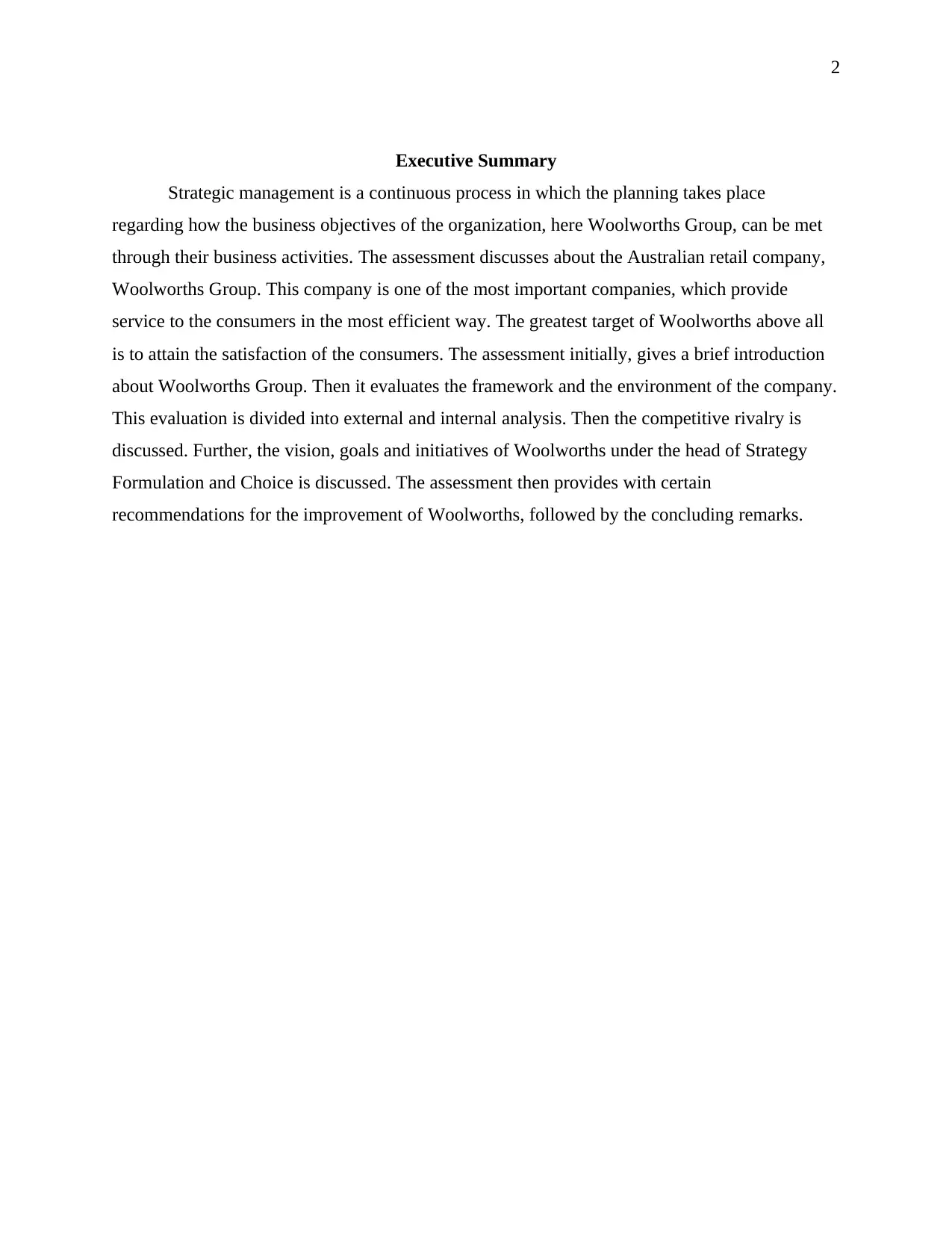
2
Executive Summary
Strategic management is a continuous process in which the planning takes place
regarding how the business objectives of the organization, here Woolworths Group, can be met
through their business activities. The assessment discusses about the Australian retail company,
Woolworths Group. This company is one of the most important companies, which provide
service to the consumers in the most efficient way. The greatest target of Woolworths above all
is to attain the satisfaction of the consumers. The assessment initially, gives a brief introduction
about Woolworths Group. Then it evaluates the framework and the environment of the company.
This evaluation is divided into external and internal analysis. Then the competitive rivalry is
discussed. Further, the vision, goals and initiatives of Woolworths under the head of Strategy
Formulation and Choice is discussed. The assessment then provides with certain
recommendations for the improvement of Woolworths, followed by the concluding remarks.
Executive Summary
Strategic management is a continuous process in which the planning takes place
regarding how the business objectives of the organization, here Woolworths Group, can be met
through their business activities. The assessment discusses about the Australian retail company,
Woolworths Group. This company is one of the most important companies, which provide
service to the consumers in the most efficient way. The greatest target of Woolworths above all
is to attain the satisfaction of the consumers. The assessment initially, gives a brief introduction
about Woolworths Group. Then it evaluates the framework and the environment of the company.
This evaluation is divided into external and internal analysis. Then the competitive rivalry is
discussed. Further, the vision, goals and initiatives of Woolworths under the head of Strategy
Formulation and Choice is discussed. The assessment then provides with certain
recommendations for the improvement of Woolworths, followed by the concluding remarks.
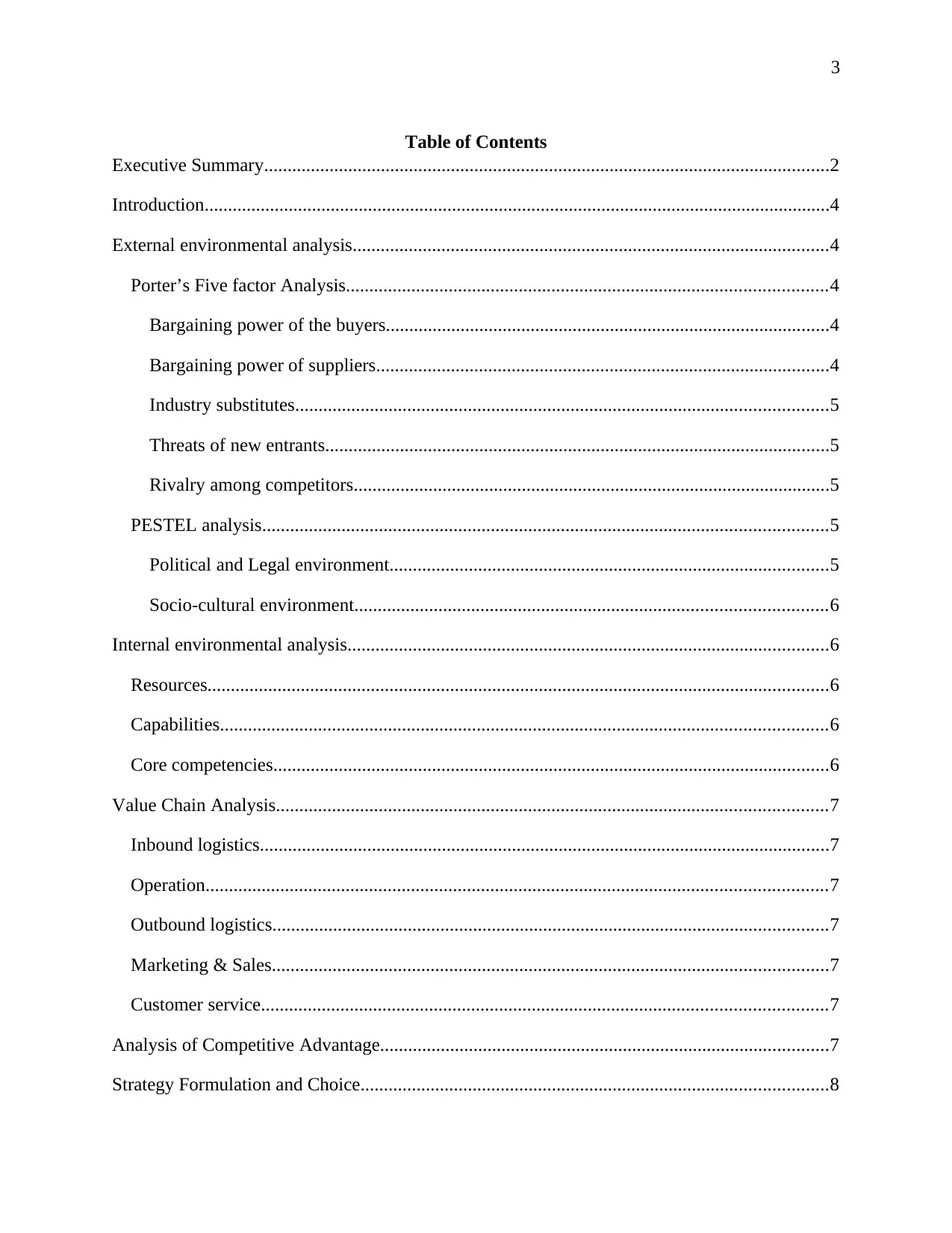
3
Table of Contents
Executive Summary.........................................................................................................................2
Introduction......................................................................................................................................4
External environmental analysis......................................................................................................4
Porter’s Five factor Analysis.......................................................................................................4
Bargaining power of the buyers...............................................................................................4
Bargaining power of suppliers.................................................................................................4
Industry substitutes..................................................................................................................5
Threats of new entrants............................................................................................................5
Rivalry among competitors......................................................................................................5
PESTEL analysis.........................................................................................................................5
Political and Legal environment..............................................................................................5
Socio-cultural environment.....................................................................................................6
Internal environmental analysis.......................................................................................................6
Resources.....................................................................................................................................6
Capabilities..................................................................................................................................6
Core competencies.......................................................................................................................6
Value Chain Analysis......................................................................................................................7
Inbound logistics..........................................................................................................................7
Operation.....................................................................................................................................7
Outbound logistics.......................................................................................................................7
Marketing & Sales.......................................................................................................................7
Customer service.........................................................................................................................7
Analysis of Competitive Advantage................................................................................................7
Strategy Formulation and Choice....................................................................................................8
Table of Contents
Executive Summary.........................................................................................................................2
Introduction......................................................................................................................................4
External environmental analysis......................................................................................................4
Porter’s Five factor Analysis.......................................................................................................4
Bargaining power of the buyers...............................................................................................4
Bargaining power of suppliers.................................................................................................4
Industry substitutes..................................................................................................................5
Threats of new entrants............................................................................................................5
Rivalry among competitors......................................................................................................5
PESTEL analysis.........................................................................................................................5
Political and Legal environment..............................................................................................5
Socio-cultural environment.....................................................................................................6
Internal environmental analysis.......................................................................................................6
Resources.....................................................................................................................................6
Capabilities..................................................................................................................................6
Core competencies.......................................................................................................................6
Value Chain Analysis......................................................................................................................7
Inbound logistics..........................................................................................................................7
Operation.....................................................................................................................................7
Outbound logistics.......................................................................................................................7
Marketing & Sales.......................................................................................................................7
Customer service.........................................................................................................................7
Analysis of Competitive Advantage................................................................................................7
Strategy Formulation and Choice....................................................................................................8
⊘ This is a preview!⊘
Do you want full access?
Subscribe today to unlock all pages.

Trusted by 1+ million students worldwide
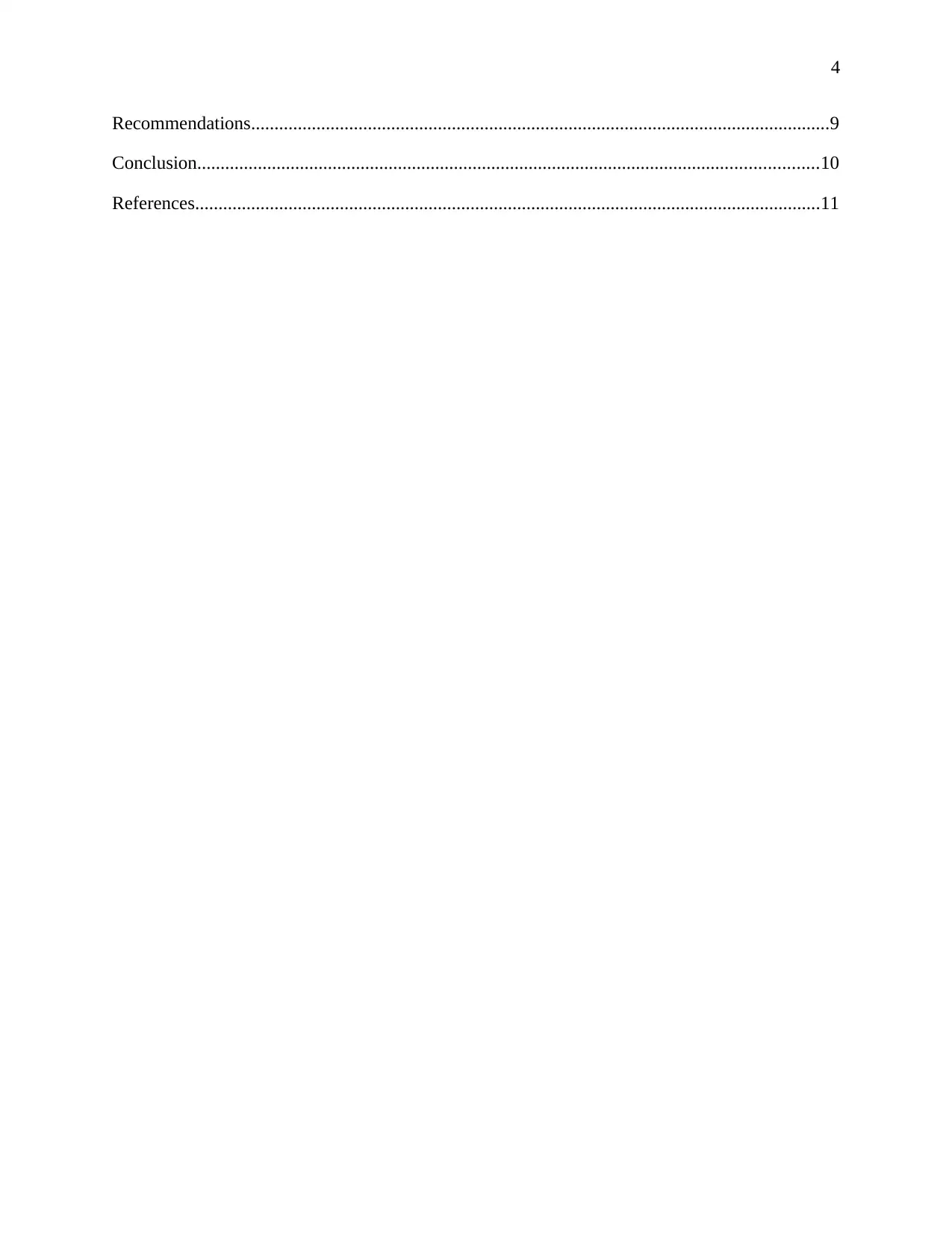
4
Recommendations............................................................................................................................9
Conclusion.....................................................................................................................................10
References......................................................................................................................................11
Recommendations............................................................................................................................9
Conclusion.....................................................................................................................................10
References......................................................................................................................................11
Paraphrase This Document
Need a fresh take? Get an instant paraphrase of this document with our AI Paraphraser
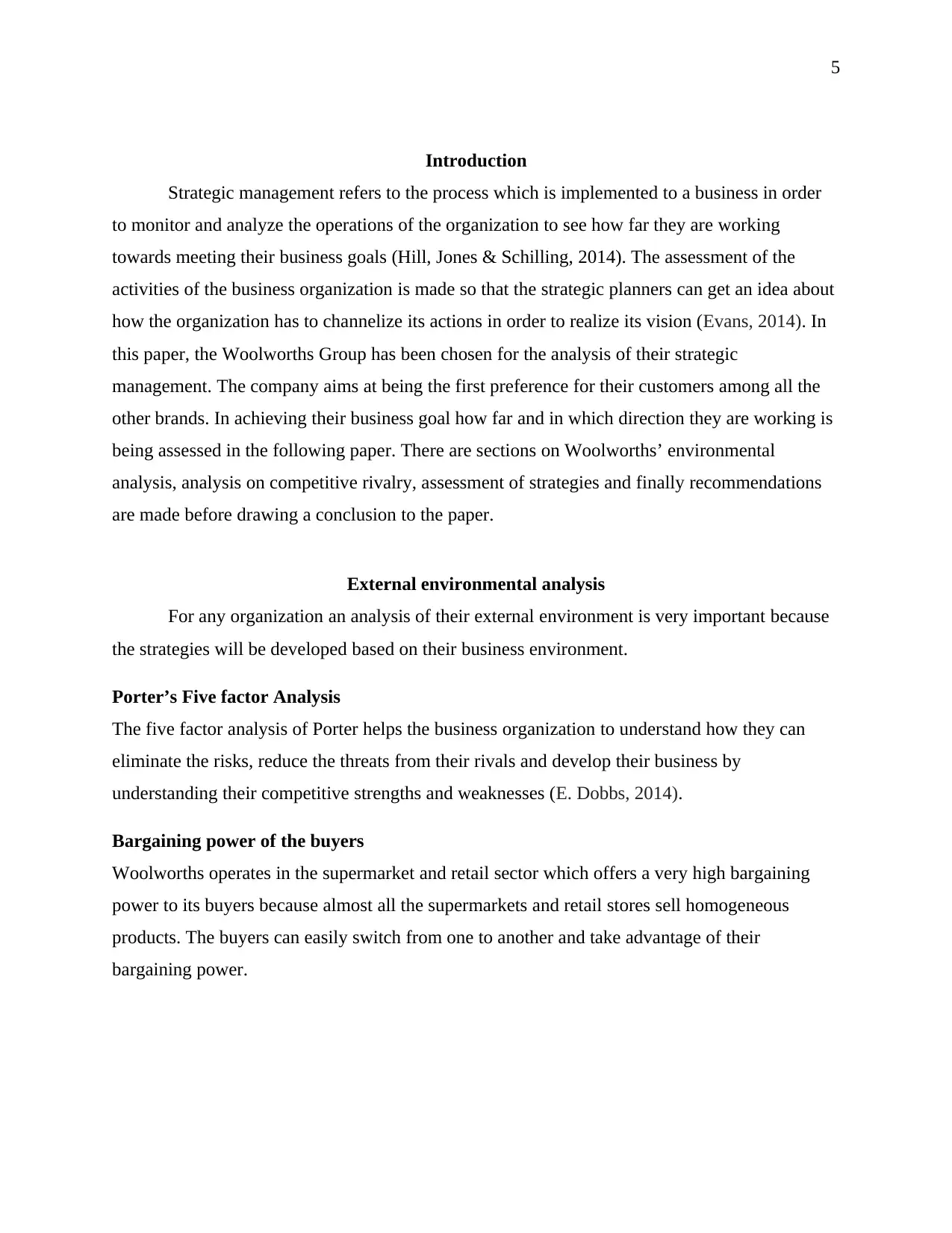
5
Introduction
Strategic management refers to the process which is implemented to a business in order
to monitor and analyze the operations of the organization to see how far they are working
towards meeting their business goals (Hill, Jones & Schilling, 2014). The assessment of the
activities of the business organization is made so that the strategic planners can get an idea about
how the organization has to channelize its actions in order to realize its vision (Evans, 2014). In
this paper, the Woolworths Group has been chosen for the analysis of their strategic
management. The company aims at being the first preference for their customers among all the
other brands. In achieving their business goal how far and in which direction they are working is
being assessed in the following paper. There are sections on Woolworths’ environmental
analysis, analysis on competitive rivalry, assessment of strategies and finally recommendations
are made before drawing a conclusion to the paper.
External environmental analysis
For any organization an analysis of their external environment is very important because
the strategies will be developed based on their business environment.
Porter’s Five factor Analysis
The five factor analysis of Porter helps the business organization to understand how they can
eliminate the risks, reduce the threats from their rivals and develop their business by
understanding their competitive strengths and weaknesses (E. Dobbs, 2014).
Bargaining power of the buyers
Woolworths operates in the supermarket and retail sector which offers a very high bargaining
power to its buyers because almost all the supermarkets and retail stores sell homogeneous
products. The buyers can easily switch from one to another and take advantage of their
bargaining power.
Introduction
Strategic management refers to the process which is implemented to a business in order
to monitor and analyze the operations of the organization to see how far they are working
towards meeting their business goals (Hill, Jones & Schilling, 2014). The assessment of the
activities of the business organization is made so that the strategic planners can get an idea about
how the organization has to channelize its actions in order to realize its vision (Evans, 2014). In
this paper, the Woolworths Group has been chosen for the analysis of their strategic
management. The company aims at being the first preference for their customers among all the
other brands. In achieving their business goal how far and in which direction they are working is
being assessed in the following paper. There are sections on Woolworths’ environmental
analysis, analysis on competitive rivalry, assessment of strategies and finally recommendations
are made before drawing a conclusion to the paper.
External environmental analysis
For any organization an analysis of their external environment is very important because
the strategies will be developed based on their business environment.
Porter’s Five factor Analysis
The five factor analysis of Porter helps the business organization to understand how they can
eliminate the risks, reduce the threats from their rivals and develop their business by
understanding their competitive strengths and weaknesses (E. Dobbs, 2014).
Bargaining power of the buyers
Woolworths operates in the supermarket and retail sector which offers a very high bargaining
power to its buyers because almost all the supermarkets and retail stores sell homogeneous
products. The buyers can easily switch from one to another and take advantage of their
bargaining power.
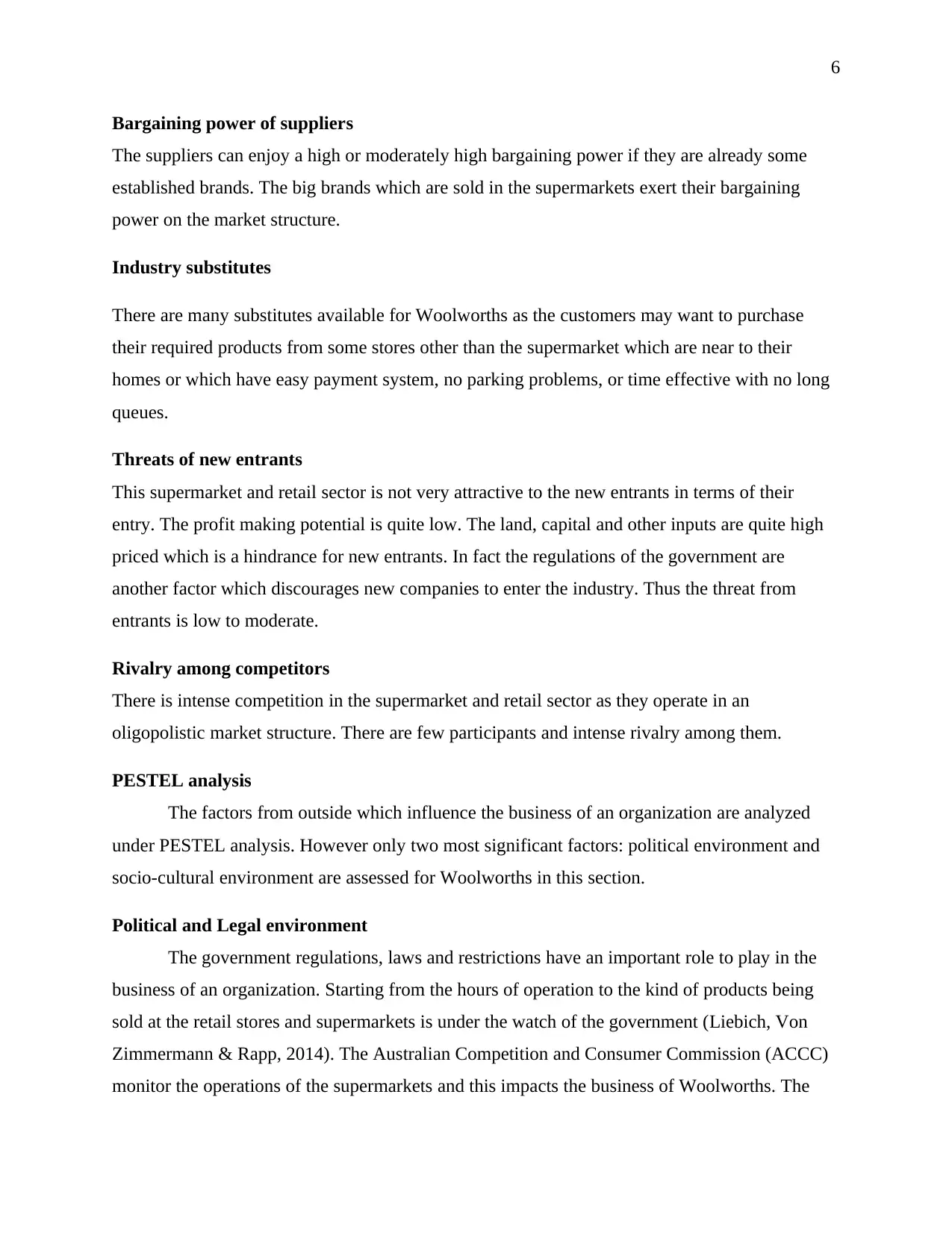
6
Bargaining power of suppliers
The suppliers can enjoy a high or moderately high bargaining power if they are already some
established brands. The big brands which are sold in the supermarkets exert their bargaining
power on the market structure.
Industry substitutes
There are many substitutes available for Woolworths as the customers may want to purchase
their required products from some stores other than the supermarket which are near to their
homes or which have easy payment system, no parking problems, or time effective with no long
queues.
Threats of new entrants
This supermarket and retail sector is not very attractive to the new entrants in terms of their
entry. The profit making potential is quite low. The land, capital and other inputs are quite high
priced which is a hindrance for new entrants. In fact the regulations of the government are
another factor which discourages new companies to enter the industry. Thus the threat from
entrants is low to moderate.
Rivalry among competitors
There is intense competition in the supermarket and retail sector as they operate in an
oligopolistic market structure. There are few participants and intense rivalry among them.
PESTEL analysis
The factors from outside which influence the business of an organization are analyzed
under PESTEL analysis. However only two most significant factors: political environment and
socio-cultural environment are assessed for Woolworths in this section.
Political and Legal environment
The government regulations, laws and restrictions have an important role to play in the
business of an organization. Starting from the hours of operation to the kind of products being
sold at the retail stores and supermarkets is under the watch of the government (Liebich, Von
Zimmermann & Rapp, 2014). The Australian Competition and Consumer Commission (ACCC)
monitor the operations of the supermarkets and this impacts the business of Woolworths. The
Bargaining power of suppliers
The suppliers can enjoy a high or moderately high bargaining power if they are already some
established brands. The big brands which are sold in the supermarkets exert their bargaining
power on the market structure.
Industry substitutes
There are many substitutes available for Woolworths as the customers may want to purchase
their required products from some stores other than the supermarket which are near to their
homes or which have easy payment system, no parking problems, or time effective with no long
queues.
Threats of new entrants
This supermarket and retail sector is not very attractive to the new entrants in terms of their
entry. The profit making potential is quite low. The land, capital and other inputs are quite high
priced which is a hindrance for new entrants. In fact the regulations of the government are
another factor which discourages new companies to enter the industry. Thus the threat from
entrants is low to moderate.
Rivalry among competitors
There is intense competition in the supermarket and retail sector as they operate in an
oligopolistic market structure. There are few participants and intense rivalry among them.
PESTEL analysis
The factors from outside which influence the business of an organization are analyzed
under PESTEL analysis. However only two most significant factors: political environment and
socio-cultural environment are assessed for Woolworths in this section.
Political and Legal environment
The government regulations, laws and restrictions have an important role to play in the
business of an organization. Starting from the hours of operation to the kind of products being
sold at the retail stores and supermarkets is under the watch of the government (Liebich, Von
Zimmermann & Rapp, 2014). The Australian Competition and Consumer Commission (ACCC)
monitor the operations of the supermarkets and this impacts the business of Woolworths. The
⊘ This is a preview!⊘
Do you want full access?
Subscribe today to unlock all pages.

Trusted by 1+ million students worldwide
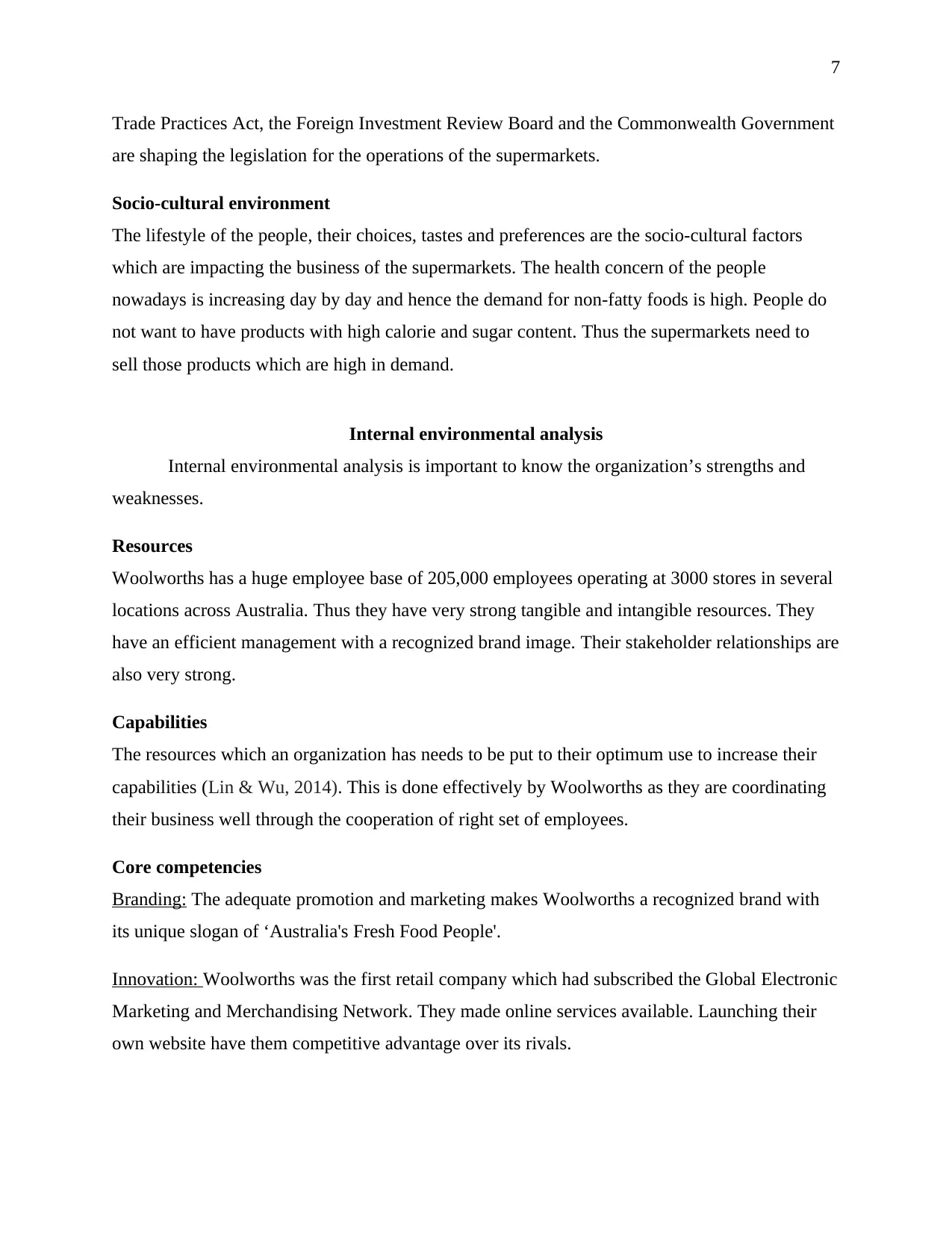
7
Trade Practices Act, the Foreign Investment Review Board and the Commonwealth Government
are shaping the legislation for the operations of the supermarkets.
Socio-cultural environment
The lifestyle of the people, their choices, tastes and preferences are the socio-cultural factors
which are impacting the business of the supermarkets. The health concern of the people
nowadays is increasing day by day and hence the demand for non-fatty foods is high. People do
not want to have products with high calorie and sugar content. Thus the supermarkets need to
sell those products which are high in demand.
Internal environmental analysis
Internal environmental analysis is important to know the organization’s strengths and
weaknesses.
Resources
Woolworths has a huge employee base of 205,000 employees operating at 3000 stores in several
locations across Australia. Thus they have very strong tangible and intangible resources. They
have an efficient management with a recognized brand image. Their stakeholder relationships are
also very strong.
Capabilities
The resources which an organization has needs to be put to their optimum use to increase their
capabilities (Lin & Wu, 2014). This is done effectively by Woolworths as they are coordinating
their business well through the cooperation of right set of employees.
Core competencies
Branding: The adequate promotion and marketing makes Woolworths a recognized brand with
its unique slogan of ‘Australia's Fresh Food People'.
Innovation: Woolworths was the first retail company which had subscribed the Global Electronic
Marketing and Merchandising Network. They made online services available. Launching their
own website have them competitive advantage over its rivals.
Trade Practices Act, the Foreign Investment Review Board and the Commonwealth Government
are shaping the legislation for the operations of the supermarkets.
Socio-cultural environment
The lifestyle of the people, their choices, tastes and preferences are the socio-cultural factors
which are impacting the business of the supermarkets. The health concern of the people
nowadays is increasing day by day and hence the demand for non-fatty foods is high. People do
not want to have products with high calorie and sugar content. Thus the supermarkets need to
sell those products which are high in demand.
Internal environmental analysis
Internal environmental analysis is important to know the organization’s strengths and
weaknesses.
Resources
Woolworths has a huge employee base of 205,000 employees operating at 3000 stores in several
locations across Australia. Thus they have very strong tangible and intangible resources. They
have an efficient management with a recognized brand image. Their stakeholder relationships are
also very strong.
Capabilities
The resources which an organization has needs to be put to their optimum use to increase their
capabilities (Lin & Wu, 2014). This is done effectively by Woolworths as they are coordinating
their business well through the cooperation of right set of employees.
Core competencies
Branding: The adequate promotion and marketing makes Woolworths a recognized brand with
its unique slogan of ‘Australia's Fresh Food People'.
Innovation: Woolworths was the first retail company which had subscribed the Global Electronic
Marketing and Merchandising Network. They made online services available. Launching their
own website have them competitive advantage over its rivals.
Paraphrase This Document
Need a fresh take? Get an instant paraphrase of this document with our AI Paraphraser
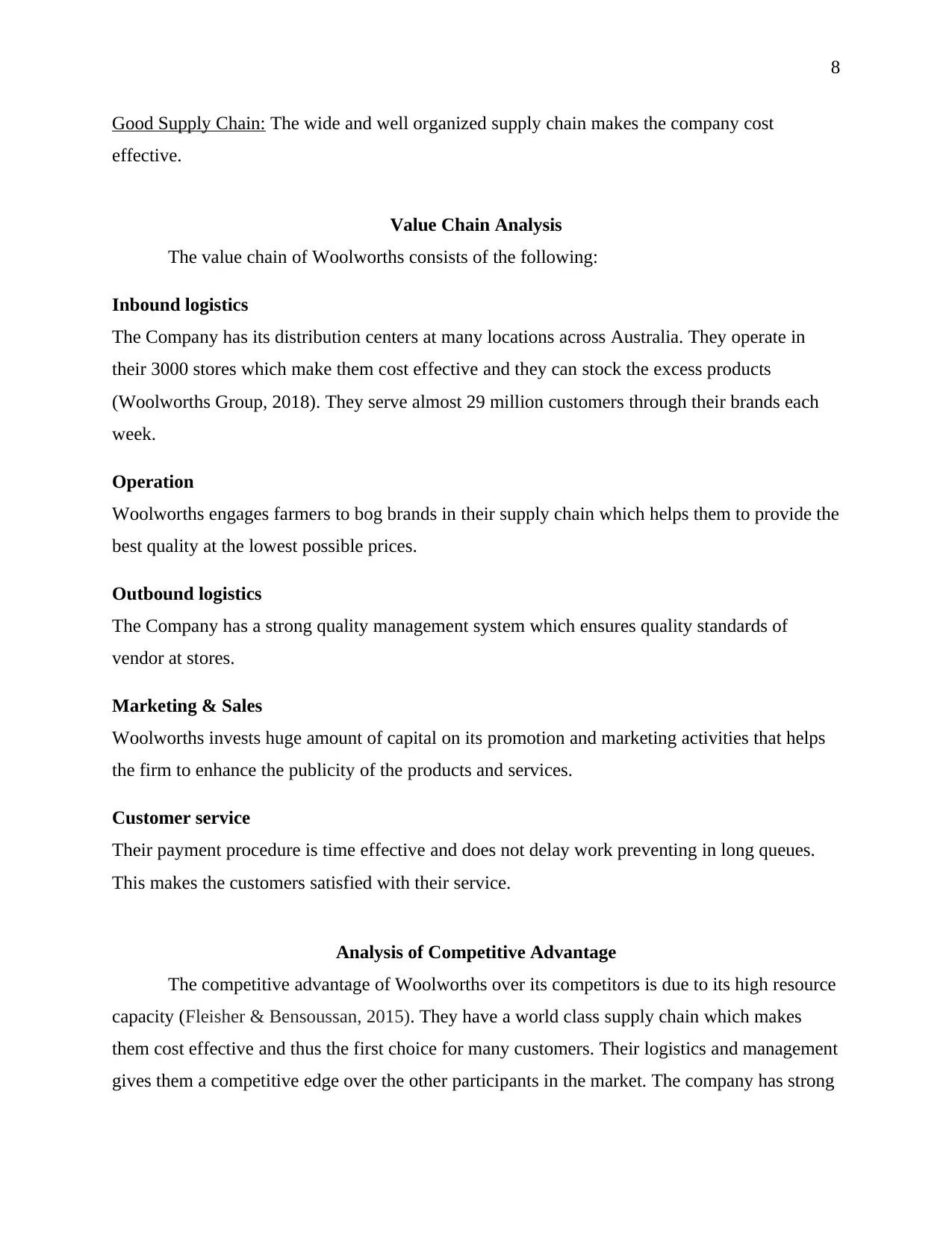
8
Good Supply Chain: The wide and well organized supply chain makes the company cost
effective.
Value Chain Analysis
The value chain of Woolworths consists of the following:
Inbound logistics
The Company has its distribution centers at many locations across Australia. They operate in
their 3000 stores which make them cost effective and they can stock the excess products
(Woolworths Group, 2018). They serve almost 29 million customers through their brands each
week.
Operation
Woolworths engages farmers to bog brands in their supply chain which helps them to provide the
best quality at the lowest possible prices.
Outbound logistics
The Company has a strong quality management system which ensures quality standards of
vendor at stores.
Marketing & Sales
Woolworths invests huge amount of capital on its promotion and marketing activities that helps
the firm to enhance the publicity of the products and services.
Customer service
Their payment procedure is time effective and does not delay work preventing in long queues.
This makes the customers satisfied with their service.
Analysis of Competitive Advantage
The competitive advantage of Woolworths over its competitors is due to its high resource
capacity (Fleisher & Bensoussan, 2015). They have a world class supply chain which makes
them cost effective and thus the first choice for many customers. Their logistics and management
gives them a competitive edge over the other participants in the market. The company has strong
Good Supply Chain: The wide and well organized supply chain makes the company cost
effective.
Value Chain Analysis
The value chain of Woolworths consists of the following:
Inbound logistics
The Company has its distribution centers at many locations across Australia. They operate in
their 3000 stores which make them cost effective and they can stock the excess products
(Woolworths Group, 2018). They serve almost 29 million customers through their brands each
week.
Operation
Woolworths engages farmers to bog brands in their supply chain which helps them to provide the
best quality at the lowest possible prices.
Outbound logistics
The Company has a strong quality management system which ensures quality standards of
vendor at stores.
Marketing & Sales
Woolworths invests huge amount of capital on its promotion and marketing activities that helps
the firm to enhance the publicity of the products and services.
Customer service
Their payment procedure is time effective and does not delay work preventing in long queues.
This makes the customers satisfied with their service.
Analysis of Competitive Advantage
The competitive advantage of Woolworths over its competitors is due to its high resource
capacity (Fleisher & Bensoussan, 2015). They have a world class supply chain which makes
them cost effective and thus the first choice for many customers. Their logistics and management
gives them a competitive edge over the other participants in the market. The company has strong
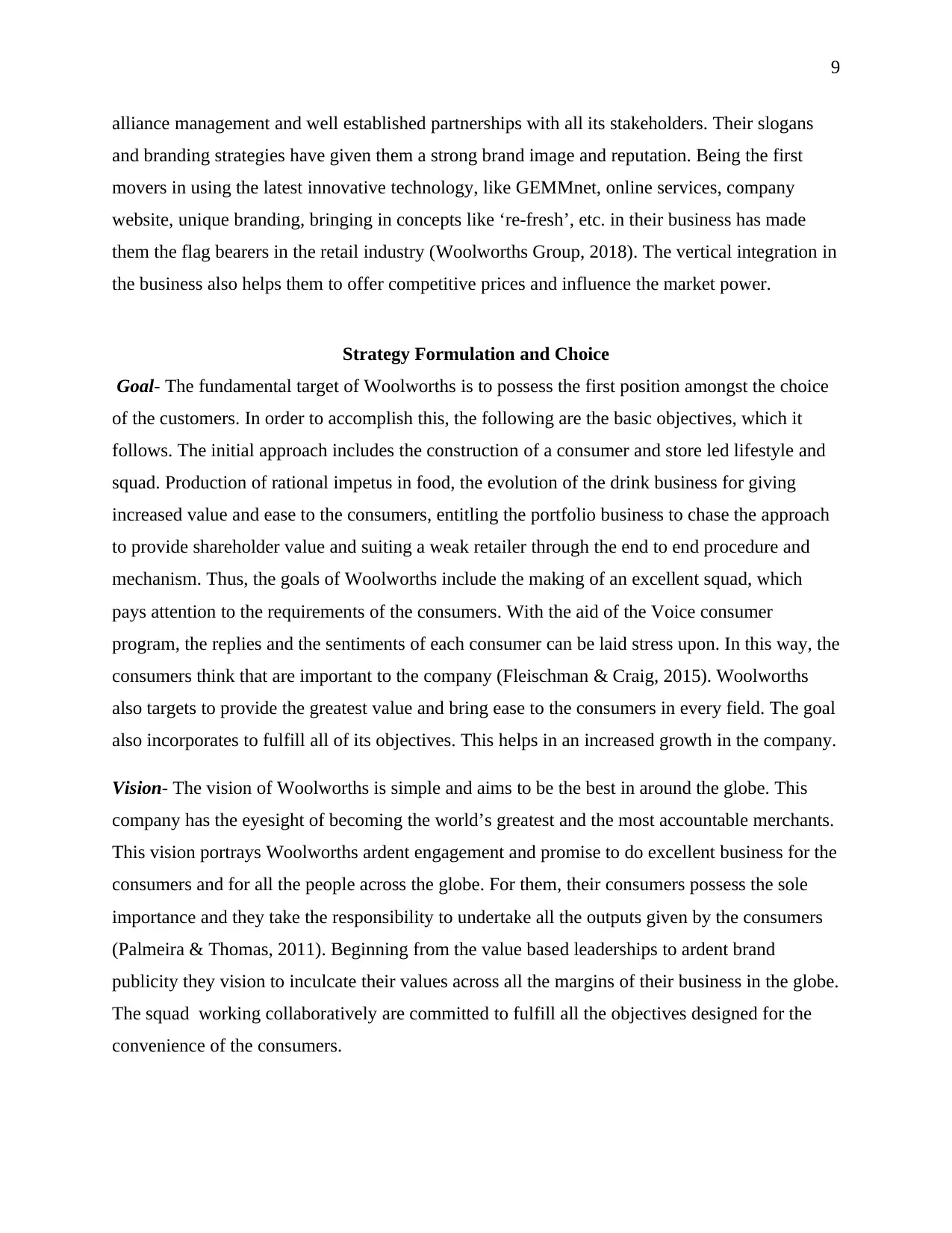
9
alliance management and well established partnerships with all its stakeholders. Their slogans
and branding strategies have given them a strong brand image and reputation. Being the first
movers in using the latest innovative technology, like GEMMnet, online services, company
website, unique branding, bringing in concepts like ‘re-fresh’, etc. in their business has made
them the flag bearers in the retail industry (Woolworths Group, 2018). The vertical integration in
the business also helps them to offer competitive prices and influence the market power.
Strategy Formulation and Choice
Goal- The fundamental target of Woolworths is to possess the first position amongst the choice
of the customers. In order to accomplish this, the following are the basic objectives, which it
follows. The initial approach includes the construction of a consumer and store led lifestyle and
squad. Production of rational impetus in food, the evolution of the drink business for giving
increased value and ease to the consumers, entitling the portfolio business to chase the approach
to provide shareholder value and suiting a weak retailer through the end to end procedure and
mechanism. Thus, the goals of Woolworths include the making of an excellent squad, which
pays attention to the requirements of the consumers. With the aid of the Voice consumer
program, the replies and the sentiments of each consumer can be laid stress upon. In this way, the
consumers think that are important to the company (Fleischman & Craig, 2015). Woolworths
also targets to provide the greatest value and bring ease to the consumers in every field. The goal
also incorporates to fulfill all of its objectives. This helps in an increased growth in the company.
Vision- The vision of Woolworths is simple and aims to be the best in around the globe. This
company has the eyesight of becoming the world’s greatest and the most accountable merchants.
This vision portrays Woolworths ardent engagement and promise to do excellent business for the
consumers and for all the people across the globe. For them, their consumers possess the sole
importance and they take the responsibility to undertake all the outputs given by the consumers
(Palmeira & Thomas, 2011). Beginning from the value based leaderships to ardent brand
publicity they vision to inculcate their values across all the margins of their business in the globe.
The squad working collaboratively are committed to fulfill all the objectives designed for the
convenience of the consumers.
alliance management and well established partnerships with all its stakeholders. Their slogans
and branding strategies have given them a strong brand image and reputation. Being the first
movers in using the latest innovative technology, like GEMMnet, online services, company
website, unique branding, bringing in concepts like ‘re-fresh’, etc. in their business has made
them the flag bearers in the retail industry (Woolworths Group, 2018). The vertical integration in
the business also helps them to offer competitive prices and influence the market power.
Strategy Formulation and Choice
Goal- The fundamental target of Woolworths is to possess the first position amongst the choice
of the customers. In order to accomplish this, the following are the basic objectives, which it
follows. The initial approach includes the construction of a consumer and store led lifestyle and
squad. Production of rational impetus in food, the evolution of the drink business for giving
increased value and ease to the consumers, entitling the portfolio business to chase the approach
to provide shareholder value and suiting a weak retailer through the end to end procedure and
mechanism. Thus, the goals of Woolworths include the making of an excellent squad, which
pays attention to the requirements of the consumers. With the aid of the Voice consumer
program, the replies and the sentiments of each consumer can be laid stress upon. In this way, the
consumers think that are important to the company (Fleischman & Craig, 2015). Woolworths
also targets to provide the greatest value and bring ease to the consumers in every field. The goal
also incorporates to fulfill all of its objectives. This helps in an increased growth in the company.
Vision- The vision of Woolworths is simple and aims to be the best in around the globe. This
company has the eyesight of becoming the world’s greatest and the most accountable merchants.
This vision portrays Woolworths ardent engagement and promise to do excellent business for the
consumers and for all the people across the globe. For them, their consumers possess the sole
importance and they take the responsibility to undertake all the outputs given by the consumers
(Palmeira & Thomas, 2011). Beginning from the value based leaderships to ardent brand
publicity they vision to inculcate their values across all the margins of their business in the globe.
The squad working collaboratively are committed to fulfill all the objectives designed for the
convenience of the consumers.
⊘ This is a preview!⊘
Do you want full access?
Subscribe today to unlock all pages.

Trusted by 1+ million students worldwide
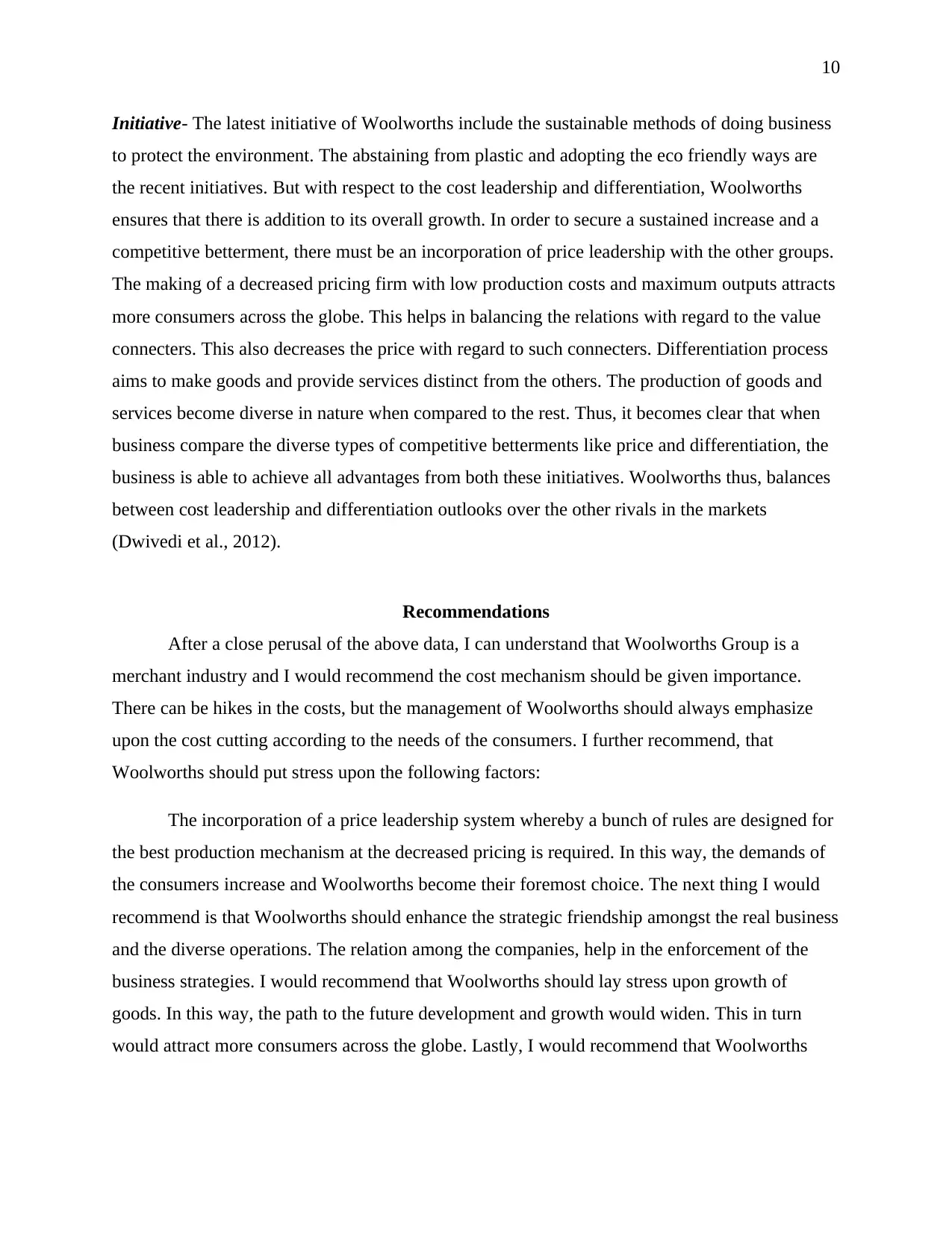
10
Initiative- The latest initiative of Woolworths include the sustainable methods of doing business
to protect the environment. The abstaining from plastic and adopting the eco friendly ways are
the recent initiatives. But with respect to the cost leadership and differentiation, Woolworths
ensures that there is addition to its overall growth. In order to secure a sustained increase and a
competitive betterment, there must be an incorporation of price leadership with the other groups.
The making of a decreased pricing firm with low production costs and maximum outputs attracts
more consumers across the globe. This helps in balancing the relations with regard to the value
connecters. This also decreases the price with regard to such connecters. Differentiation process
aims to make goods and provide services distinct from the others. The production of goods and
services become diverse in nature when compared to the rest. Thus, it becomes clear that when
business compare the diverse types of competitive betterments like price and differentiation, the
business is able to achieve all advantages from both these initiatives. Woolworths thus, balances
between cost leadership and differentiation outlooks over the other rivals in the markets
(Dwivedi et al., 2012).
Recommendations
After a close perusal of the above data, I can understand that Woolworths Group is a
merchant industry and I would recommend the cost mechanism should be given importance.
There can be hikes in the costs, but the management of Woolworths should always emphasize
upon the cost cutting according to the needs of the consumers. I further recommend, that
Woolworths should put stress upon the following factors:
The incorporation of a price leadership system whereby a bunch of rules are designed for
the best production mechanism at the decreased pricing is required. In this way, the demands of
the consumers increase and Woolworths become their foremost choice. The next thing I would
recommend is that Woolworths should enhance the strategic friendship amongst the real business
and the diverse operations. The relation among the companies, help in the enforcement of the
business strategies. I would recommend that Woolworths should lay stress upon growth of
goods. In this way, the path to the future development and growth would widen. This in turn
would attract more consumers across the globe. Lastly, I would recommend that Woolworths
Initiative- The latest initiative of Woolworths include the sustainable methods of doing business
to protect the environment. The abstaining from plastic and adopting the eco friendly ways are
the recent initiatives. But with respect to the cost leadership and differentiation, Woolworths
ensures that there is addition to its overall growth. In order to secure a sustained increase and a
competitive betterment, there must be an incorporation of price leadership with the other groups.
The making of a decreased pricing firm with low production costs and maximum outputs attracts
more consumers across the globe. This helps in balancing the relations with regard to the value
connecters. This also decreases the price with regard to such connecters. Differentiation process
aims to make goods and provide services distinct from the others. The production of goods and
services become diverse in nature when compared to the rest. Thus, it becomes clear that when
business compare the diverse types of competitive betterments like price and differentiation, the
business is able to achieve all advantages from both these initiatives. Woolworths thus, balances
between cost leadership and differentiation outlooks over the other rivals in the markets
(Dwivedi et al., 2012).
Recommendations
After a close perusal of the above data, I can understand that Woolworths Group is a
merchant industry and I would recommend the cost mechanism should be given importance.
There can be hikes in the costs, but the management of Woolworths should always emphasize
upon the cost cutting according to the needs of the consumers. I further recommend, that
Woolworths should put stress upon the following factors:
The incorporation of a price leadership system whereby a bunch of rules are designed for
the best production mechanism at the decreased pricing is required. In this way, the demands of
the consumers increase and Woolworths become their foremost choice. The next thing I would
recommend is that Woolworths should enhance the strategic friendship amongst the real business
and the diverse operations. The relation among the companies, help in the enforcement of the
business strategies. I would recommend that Woolworths should lay stress upon growth of
goods. In this way, the path to the future development and growth would widen. This in turn
would attract more consumers across the globe. Lastly, I would recommend that Woolworths
Paraphrase This Document
Need a fresh take? Get an instant paraphrase of this document with our AI Paraphraser

11
should recruit people from diverse backgrounds and culture. In this way, the greatest quality
service can be achieved from the employees possessing the diverse cultures.
Conclusion
It can be concluded thus, that Woolworths holds one of the most trusted and promising
group in Australia. It successfully aims at the desires of its consumers and satisfies them in the
best possible way. It has incorporated in itself the vision of becoming the company chosen by all
the people across the globe. The passionate commitment towards serving the people and seeking
their satisfaction is of utmost importance in their approach. The recommendations stated above
would aid them to hold their position consistently in the future.
should recruit people from diverse backgrounds and culture. In this way, the greatest quality
service can be achieved from the employees possessing the diverse cultures.
Conclusion
It can be concluded thus, that Woolworths holds one of the most trusted and promising
group in Australia. It successfully aims at the desires of its consumers and satisfies them in the
best possible way. It has incorporated in itself the vision of becoming the company chosen by all
the people across the globe. The passionate commitment towards serving the people and seeking
their satisfaction is of utmost importance in their approach. The recommendations stated above
would aid them to hold their position consistently in the future.
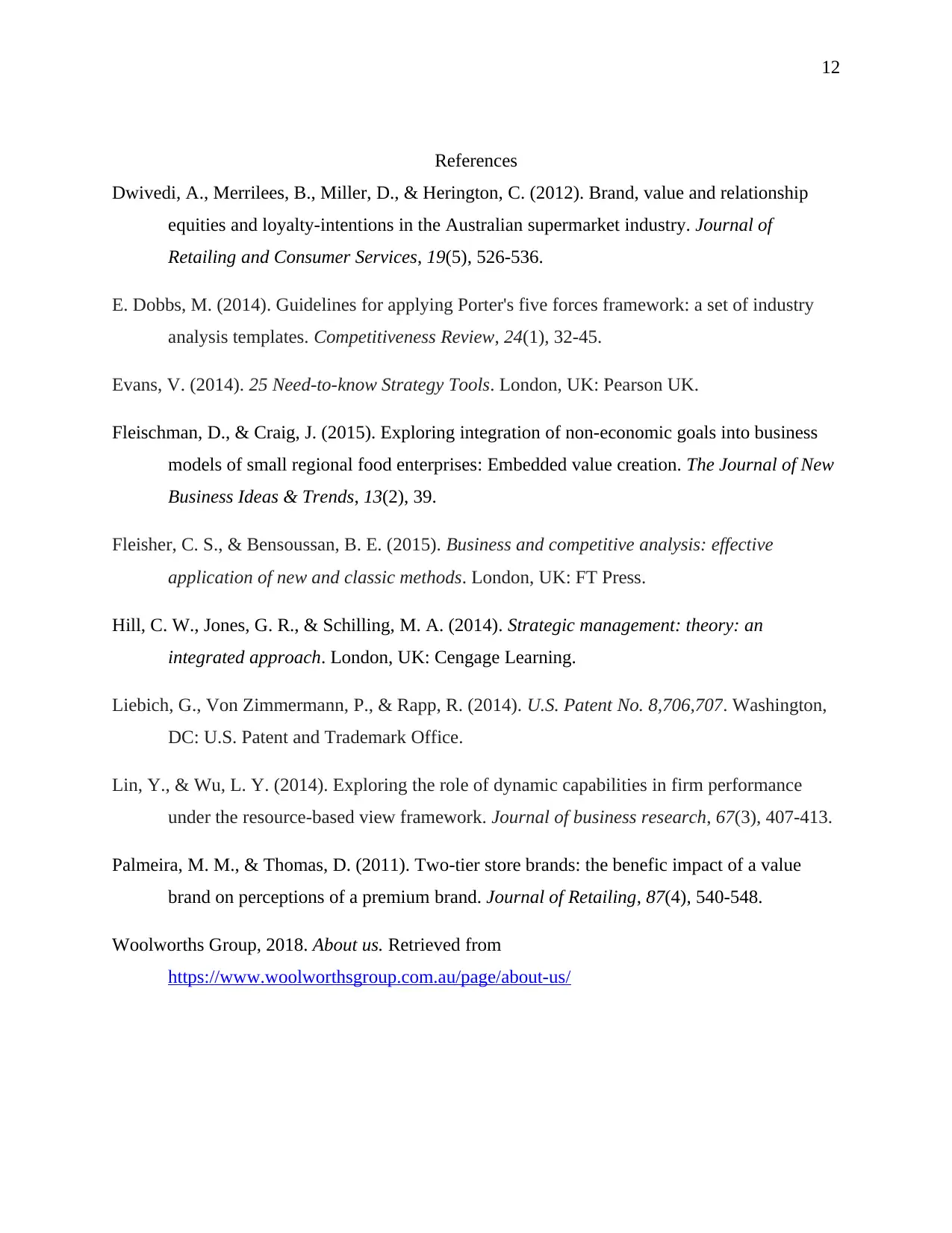
12
References
Dwivedi, A., Merrilees, B., Miller, D., & Herington, C. (2012). Brand, value and relationship
equities and loyalty-intentions in the Australian supermarket industry. Journal of
Retailing and Consumer Services, 19(5), 526-536.
E. Dobbs, M. (2014). Guidelines for applying Porter's five forces framework: a set of industry
analysis templates. Competitiveness Review, 24(1), 32-45.
Evans, V. (2014). 25 Need-to-know Strategy Tools. London, UK: Pearson UK.
Fleischman, D., & Craig, J. (2015). Exploring integration of non-economic goals into business
models of small regional food enterprises: Embedded value creation. The Journal of New
Business Ideas & Trends, 13(2), 39.
Fleisher, C. S., & Bensoussan, B. E. (2015). Business and competitive analysis: effective
application of new and classic methods. London, UK: FT Press.
Hill, C. W., Jones, G. R., & Schilling, M. A. (2014). Strategic management: theory: an
integrated approach. London, UK: Cengage Learning.
Liebich, G., Von Zimmermann, P., & Rapp, R. (2014). U.S. Patent No. 8,706,707. Washington,
DC: U.S. Patent and Trademark Office.
Lin, Y., & Wu, L. Y. (2014). Exploring the role of dynamic capabilities in firm performance
under the resource-based view framework. Journal of business research, 67(3), 407-413.
Palmeira, M. M., & Thomas, D. (2011). Two-tier store brands: the benefic impact of a value
brand on perceptions of a premium brand. Journal of Retailing, 87(4), 540-548.
Woolworths Group, 2018. About us. Retrieved from
https://www.woolworthsgroup.com.au/page/about-us/
References
Dwivedi, A., Merrilees, B., Miller, D., & Herington, C. (2012). Brand, value and relationship
equities and loyalty-intentions in the Australian supermarket industry. Journal of
Retailing and Consumer Services, 19(5), 526-536.
E. Dobbs, M. (2014). Guidelines for applying Porter's five forces framework: a set of industry
analysis templates. Competitiveness Review, 24(1), 32-45.
Evans, V. (2014). 25 Need-to-know Strategy Tools. London, UK: Pearson UK.
Fleischman, D., & Craig, J. (2015). Exploring integration of non-economic goals into business
models of small regional food enterprises: Embedded value creation. The Journal of New
Business Ideas & Trends, 13(2), 39.
Fleisher, C. S., & Bensoussan, B. E. (2015). Business and competitive analysis: effective
application of new and classic methods. London, UK: FT Press.
Hill, C. W., Jones, G. R., & Schilling, M. A. (2014). Strategic management: theory: an
integrated approach. London, UK: Cengage Learning.
Liebich, G., Von Zimmermann, P., & Rapp, R. (2014). U.S. Patent No. 8,706,707. Washington,
DC: U.S. Patent and Trademark Office.
Lin, Y., & Wu, L. Y. (2014). Exploring the role of dynamic capabilities in firm performance
under the resource-based view framework. Journal of business research, 67(3), 407-413.
Palmeira, M. M., & Thomas, D. (2011). Two-tier store brands: the benefic impact of a value
brand on perceptions of a premium brand. Journal of Retailing, 87(4), 540-548.
Woolworths Group, 2018. About us. Retrieved from
https://www.woolworthsgroup.com.au/page/about-us/
⊘ This is a preview!⊘
Do you want full access?
Subscribe today to unlock all pages.

Trusted by 1+ million students worldwide
1 out of 12
Related Documents
Your All-in-One AI-Powered Toolkit for Academic Success.
+13062052269
info@desklib.com
Available 24*7 on WhatsApp / Email
![[object Object]](/_next/static/media/star-bottom.7253800d.svg)
Unlock your academic potential
Copyright © 2020–2025 A2Z Services. All Rights Reserved. Developed and managed by ZUCOL.





